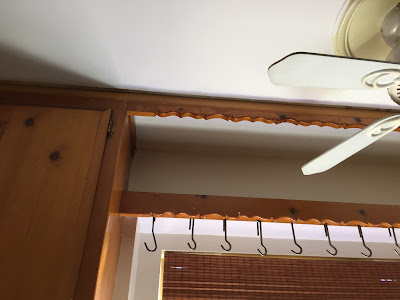This sounded great in theory, but I was dealing with layers of gloppy varnish. And the top layer was flaking off in big orange chunks after coming in contact with blue painters tape on previous projects.
I didn't trust this volatile surface and thought there's no way I could skip the sanding step.
I was in it for the long haul. But I was arming myself with two very important assets.
1. New power tools
2. A reasonable schedule
It would be hard to accomplish such a great amount of work when there were already so many demands on my time. To overcome this, I made a schedule that would mean working weeknights, after bedtime, on little pieces of prep work --cleaning, contact paper removal, filling holes in the wood, packing up dishes. Then, I'd take two vacation days so I could work uninterrupted while the children were at preschool and daycare as usual. By the end of those two days, I'd be basically done.
As it turns out, by the end of those two days, the kitchen still looked like this.
And that's because I couldn't do even a fraction of the work I'd planned to do leading up to those heavy lifting days. And that's because when I generated the schedule I'd mistakenly made a few assumptions:
No one needs to use the kitchen when cooking dinner
The members of our family would not take turns with a stomach bug over the course of one week
That Milo would need to sleep
That I would not need to sleep
That removing the paper liner on the shelves wouldn't take the better part of a day.
 |
| What fresh hell is this? |
I really don't know how I could've tried any harder to be efficient except maybe to have never started this project in the first place. And that's not a very good thought to have. But between eager beginnings and exhausted despair, there were details. Let me share them with you.
I removed gross handles.
I removed doors.
I cleaned each, meticulously.
I sanded, using a circular sander for bigger areas.
Then coming in with a detail sander.
I learned some things along the way. For one, it isn't as easy as you might think to "lightly sand" something. Once you start, it doesn't feel like you've achieved anything unless you actually get down to the bare wood.
Also, I really underestimated how far sanding dust will travel. I'd laid down some drop cloths in the adjacent living room, but this stuff went everywhere. A full week later I was still wiping it off of surfaces in every room in the house. Literally every room. The dust rounded multiple corners and went down hallways. It's incredible.
As grumbly as I was feeling, I knew I'd start to feel better once paint actually started to go on. This happened late one night, a few days after the sanding bonanza.
Then night after night, I painted, until 1:30 or 2 am, listening to the audiobook of a YA novel I had to read for a project at work. I didn't feel tired because it never seemed like it was taking as long as it was. And not in a "time flies when you're having fun" sort of way. Like in a weird wormhole kind of way. I would paint five doors and feel like it was just taking about an hour, when really it took six. Over an hour per door? It makes no goddamn sense.
While I was lost in spacetime, the paint was busy making the squiggles less offensive.
It made this neighboring wood beam accent stand out more instead of blending into the sea of endless pine.
Because I'd gone a little overboard with sanding in some places, the wood grain became more prominent. But these details looked nice in gray.
I will say, working with this highly recommended paint, that I found it to be less forgiving than regular latex. You can really tell if you've been uneven with layers, missed a spot or tried to fill one in. So I guess my recommendation would be to paint cautiously and carefully, and not hurriedly, in a dark kitchen, in the wee hours of the morning while listening to YA fiction about teenagers making out and murdering each other.
Up next: I put the hard in hardware.






























